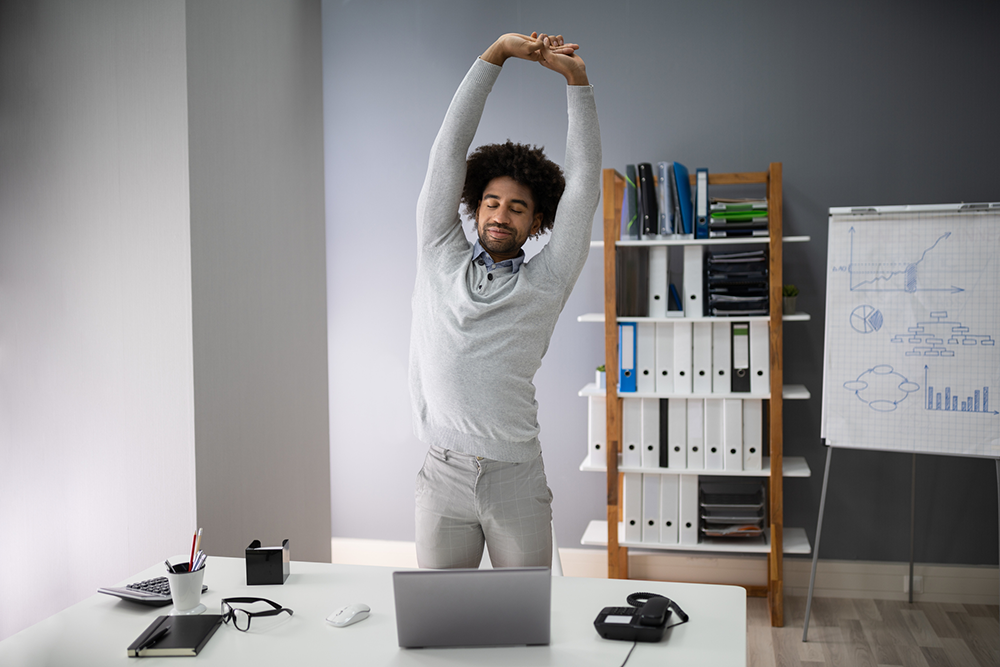
The standing vs. sitting debate has received a lot of attention recently, primarily due to the advent of the standing desk and some health reports claiming both benefits and warnings. But at the end of the day, how these positions make you feel is most important, especially for your legs.
Whether standing or sitting is better for you is still up for debate, but sensational headlines that link sitting, for example, to increased factors for premature death have made people, well, stand up and pay attention to the health issues around this topic.
The European Journal of Preventative Cardiology (2017) published a study that found that standing for 6 hours per day rather than sitting can prevent weight gain and help in losing some of those pounds. They estimated that a 143-lb person can burn an extra 54 calories per day with this routine.
According to the Mayo Clinic, when you sit, you use less energy than you do when you stand or move. Research has linked sitting for long periods of time with a number of health concerns. They include obesity, increased blood pressure, high blood sugar, excess body fat around the waist and abnormal cholesterol levels. Too much sitting overall and prolonged periods of sitting also seem to increase the risk of death from cardiovascular disease and cancer.
It seems logical that it takes more effort — and extra calories — to remain upright rather than sit, and over a course of days or weeks those extra calories would add up to something significant. However, according to a Harvard Medical School article that describes a study where 74 healthy people were measured on their calorie burn while doing computer work, watching TV, standing, or walking on a treadmill, they found the following:
- While sitting, study subjects burned 80 calories/hour — about the same as typing or watching TV
- While standing, the number of calories burned was only slightly higher than while sitting — about 88 calories/hour
- Walking burned 210 calories/hour
While this study suggests that standing is unlikely to help in a meaningful way with weight loss or avoiding weight gain, there may be other benefits. For example, after a meal, blood sugar levels return to normal faster on days a person spends more time standing. And standing, rather than sitting, may reduce the risk of shoulder and back pain.
According to a Stanford University back pain study, workers who used sit-stand desks instead of regular desks while working were more likely to report a pain-free day. Another study from the NIH also reports that transitioning from a seated to a standing position every 30 minutes during the workday can significantly reduce fatigue levels and lower back discomfort in overweight/obese office workers.
The impact of movement — even leisurely movement — is extremely helpful. Also, physical activity helps maintain muscle tone, your ability to move and your mental well-being, especially as you age. But, why do your legs hurt when you stand or even sit too long?
Persistent leg pain certainly warrants a visit to your doctor for evaluation. Leg pain can have many causes, but aching after prolonged standing or sitting suggests a possible buildup of fluid in the leg veins which are indicators of chronic venous insufficiency
Venous reflux disease occurs when the valves in your leg veins don't work properly to keep blood moving efficiently from your legs to your heart. Instead, blood pools in your legs and feet, causing pain and swelling. The pain is typically described as a burning or cramping sensation, mainly in the calf.
Past inflammation of a vein (phlebitis) may damage the valves and lead to chronic venous disease. Poor function of the valves in the leg veins also contributes to varicose veins — distended veins visible just beneath the skin. Varicose veins also may lead to chronic venous disease.
How to Ease Leg Pain
- Avoid long periods of standing or sitting: If you must take a long trip and will be sitting for a long time, flex and extend your legs, feet, and ankles about 10 times every 30 minutes to keep the blood flowing in the leg veins. If you need to stand for long periods of time, take frequent breaks to sit down and elevate your feet.
- Exercise regularly. Walking is especially beneficial.
- Lose weight if you are overweight.
- Elevate your legs while sitting and lying down, with your legs elevated above the level of your heart.
- Wear compression stockings.
- Take antibiotics as needed to treat skin infections.
- Practice good skin hygiene.
Is standing all day better than sitting? It depends. Standing all day and overdoing it can in fact be just as bad for you as sitting at your desk all day. If you are not used to standing for lengthy periods of time (or even exercising), then you should not be expected to do so immediately. If you do too much too quickly, all you will get is fatigue, joint and muscle pain, and swelling. So, start slowly and work your way up.
And if you are feeling chronic leg pain from either standing or sitting, call to make an appointment today with one of our board-certified vascular physicians.







